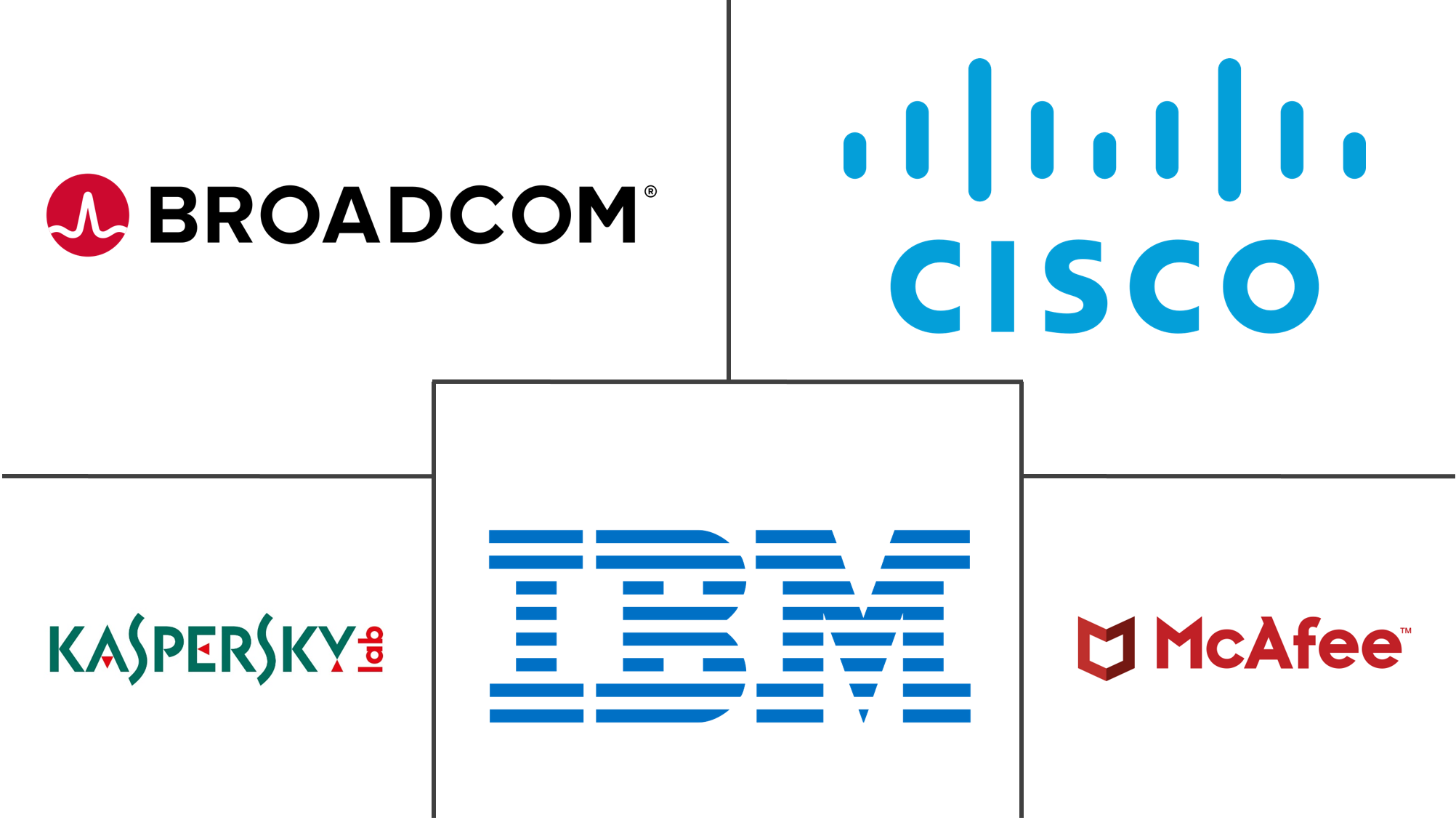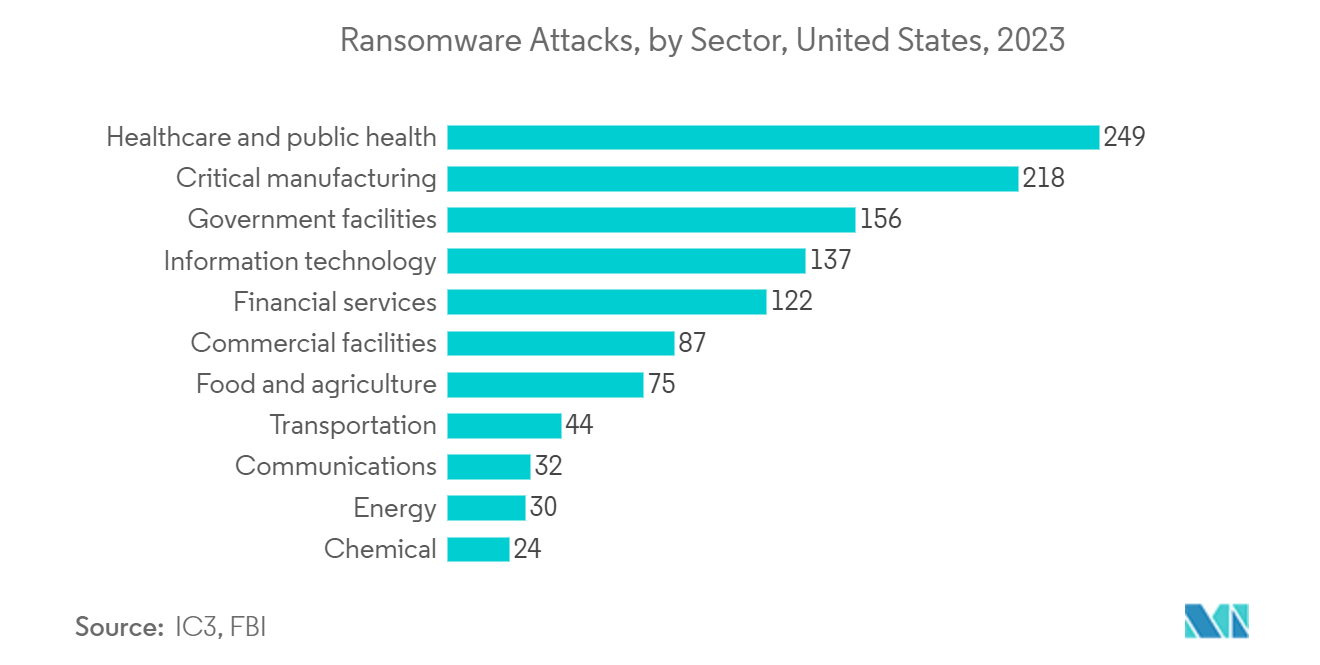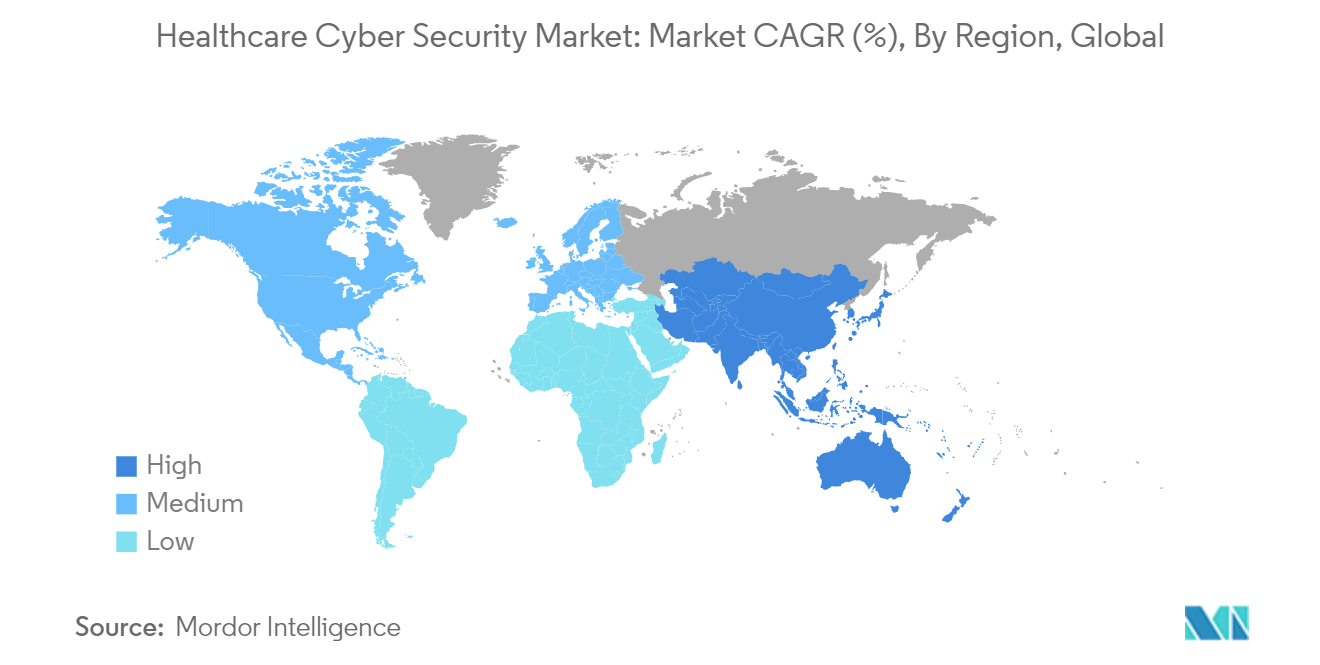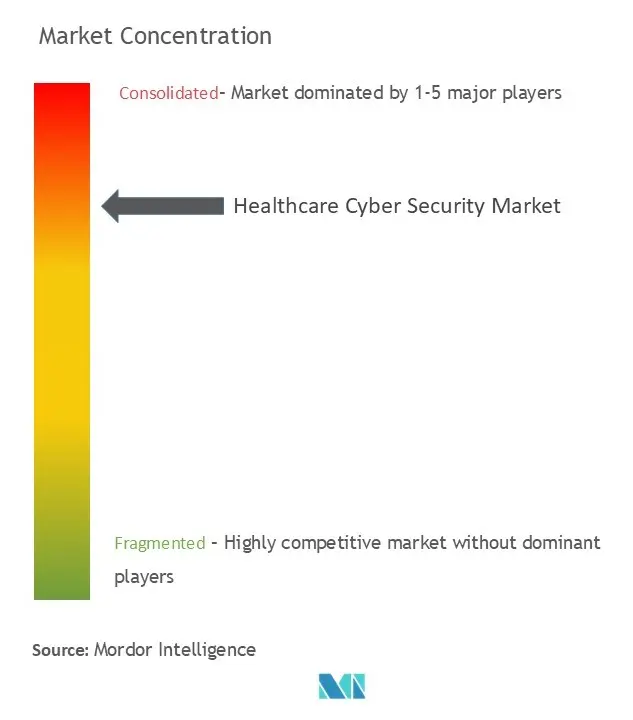Healthcare Cyber Security Market Size

| Study Period | 2019 - 2029 |
| Market Size (2024) | USD 29.53 Billion |
| Market Size (2029) | USD 60.24 Billion |
| CAGR (2024 - 2029) | 15.32 % |
| Fastest Growing Market | Asia Pacific |
| Largest Market | North America |
Major Players
*Disclaimer: Major Players sorted in no particular order |
Healthcare Cyber Security Market Analysis
The Healthcare Cyber Security Market size is estimated at USD 29.53 billion in 2024, and is expected to reach USD 60.24 billion by 2029, growing at a CAGR of 15.32% during the forecast period (2024-2029).
- Escalating Cyber Threats Drive Healthcare Security Market: The Healthcare Cyber Security Market is experiencing significant growth, driven by an escalating wave of cyberattacks targeting the healthcare sector. Healthcare organizations face unprecedented risks, with ransomware attacks increasing by 755% in 2021. This surge in threats is forcing healthcare providers to bolster their cybersecurity infrastructure, safeguarding critical patient data and ensuring operational continuity.
- Cyberattack Impact: According to the IBM Cost of a Data Breach Report, healthcare had the highest average data breach cost, reaching $7.13 million in 2020.
- Widespread Incidents: The CyberPeace Institute recorded over 235 cyberattacks on healthcare organizations in 33 countries, resulting in the theft of more than 10 million patient records.
- High-Profile Attack: The ransomware attack on Ireland's Health Service Executive (HSE) in May 2021 highlights the sector’s vulnerability and urgent need for advanced protection.
- Cloud Adoption Accelerates Cybersecurity Demand: The rapid adoption of cloud services in healthcare is creating both challenges and opportunities in cybersecurity. Hybrid cloud solutions, which enhance operational efficiency and data analytics, are being embraced to manage costs. However, this shift increases the need for robust cybersecurity measures to protect sensitive patient information across diverse cloud platforms.
- Cloud Integration Growth: Nutanix projects that healthcare organizations will increase hybrid cloud deployments by 32 percentage points over the next five years.
- Strategic Partnerships: Major institutions like Cleveland Clinic are collaborating with tech companies such as IBM to harness hybrid cloud, AI, and quantum computing technologies.
- Guidelines for Cloud Security: The European Union Agency for Cybersecurity (ENISA) has released cloud security guidelines specifically for healthcare, underscoring the growing need for secure cloud infrastructures.
- Inadequate Security Infrastructure Poses Risks: A significant gap in healthcare information security infrastructure presents both risks and opportunities. Many healthcare organizations have limited cybersecurity training and outdated infrastructure, leaving them vulnerable to breaches. This gap is fueling demand for customized cybersecurity solutions designed to meet healthcare providers' unique needs.
- Training Gaps: NordLocker’s survey revealed that 56% of healthcare employees have not received any cybersecurity training from their current employers.
- Regional Disparities: In India, the adoption of Healthcare Information Technology (HIT) remains low compared to developed nations due to underfunding and limited IT expertise.
- Growing mHealth Market: The rapid growth of the mHealth market in India signals a pressing need for mobile-specific cybersecurity solutions as healthcare organizations adopt mobile technologies.
- Market Dynamics Shaped by Regulatory Pressures: Regulatory frameworks such as HIPAA in the U.S. are playing a pivotal role in driving the Healthcare Cyber Security Market. These regulations require strict data protection measures, compelling healthcare organizations to invest in compliant cybersecurity solutions.
- Data Breach Incidents: The U.S. Department of Health and Human Services reported that hacking incidents accounted for most data breaches involving 500+ patient records in 2021.
- EHR Systems: The increasing adoption of electronic health records (EHR) mandates robust security protocols to protect patient data.
- ROI-Driven Adoption: Vendors are focusing on demonstrating a return on investment (ROI) by improving the efficiency of cybersecurity systems, which is crucial for overcoming implementation barriers.
- Emerging Technologies Reshape Security Landscape: The rise of Internet of Things (IoT) devices and artificial intelligence (AI) in healthcare is introducing new cybersecurity challenges. These technologies increase the attack surface and demand specialized security solutions, prompting vendors to develop AI-powered tools and IoT-specific protection.
- IoT Device Risks: A 2022 report revealed that one-third of bedside IoT devices in healthcare have critical vulnerabilities that could be exploited by cybercriminals.
- AI Integration: The U.S. Department of Health and Human Services is using AI-powered SaaS tools for tasks such as grant application analysis, showing the growing role of AI in healthcare operations.
- Medical Device Security: Cybersecurity companies are creating solutions that safeguard the increasingly interconnected ecosystem of medical devices and data systems, addressing the evolving healthcare threat landscape.
Healthcare Cyber Security Market Trends
Risk and Compliance Management Largest Solution Segment
Risk and compliance management is the largest solution segment in the Healthcare Cyber Security Market, driven by increasing regulatory pressures and the need to protect sensitive patient data. In 2021, this segment accounted for 28.97% of the market share, underscoring its dominance.
- Revenue Generation: The risk and compliance management segment generated USD 5.41 billion in 2021, capturing 28.95% of the market. This figure is expected to rise to USD 15.27 billion by 2027, with a projected CAGR of 18.88%.
- Regulatory Pressure: The complexity of evolving cyber threats and compliance with regulations such as HIPAA are key drivers for the segment’s growth. Healthcare’s high data breach costs, highlighted by IBM's report, further emphasize the need for robust compliance frameworks.
- Growing Awareness: The importance of risk and compliance management solutions is growing among healthcare organizations, exemplified by partnerships like that between SailPoint and Canadian healthcare providers, which address data residency and streamline identity management.
- Compliance Solutions: As cyber threats evolve and regulations tighten, the demand for comprehensive risk and compliance management solutions will continue to grow, securing the segment’s leading position in the market.

Asia-Pacific: Fastest-Growing Regional Segment
The Asia-Pacific region has emerged as the fastest-growing segment in the Healthcare Cyber Security Market, driven by rapid healthcare digitization, rising cyber threats, and increasing data protection awareness.
- Market Value: In 2021, the Asia-Pacific healthcare cybersecurity market was valued at USD 3.92 billion, representing 20.97% of the global market. The region is projected to reach USD 12.08 billion by 2027, with a CAGR of 20.63%.
- Technology Adoption: The region’s rapid adoption of digital health technologies, such as telehealth and AI-driven healthcare solutions, necessitates more robust cybersecurity infrastructure. For instance, Singapore’s Woodlands Health Campus will heavily rely on telehealth, robotics, and AI.
- Cyber Threats: High-profile breaches like the 2018 SingHealth data breach, which affected 1.5 million patients, and the 2021 attack on Eye & Retina Surgeons have fueled investments in cybersecurity across the region.
- Cloud-Based Solutions: The adoption of cloud platforms for managing patient information is simplifying the implementation of cybersecurity protocols in the Asia-Pacific healthcare sector, accelerating market growth.

Healthcare Cyber Security Industry Overview
Healthcare Cyber Security Market Competitive Landscape Analysis: The Healthcare Cyber Security Market is dominated by global players, with the competitive landscape characterized by high barriers to entry due to stringent regulations and advanced technological demands. The market remains fairly consolidated, with a few key players holding significant market share.
Market Leaders: Major companies such as Cisco Systems Inc., IBM Corporation, Kaspersky Labs Inc., and FireEye Inc. dominate the market. These leaders offer comprehensive solutions that address threat detection, prevention, and response needs specific to healthcare.
Research & Development: Continuous investment in research and development helps market leaders stay ahead of evolving threats. For example, CloudMD Software & Services Inc. enhanced its capabilities by acquiring IDYA4 to provide integrated cybersecurity and healthcare solutions.
Acquisitions & Partnerships: Partnerships with healthcare providers and strategic acquisitions are critical for expanding product portfolios and market reach. These collaborations help cybersecurity firms tailor their offerings to the complex needs of the healthcare sector.
Innovation and Compliance Drive Market Success: Market leaders must focus on continuous innovation, particularly in threat detection, prevention, and compliance, to stay competitive. Addressing challenges posed by IoT and AI applications will be essential.
AI-Driven Solutions: Companies that develop AI-driven cybersecurity tools capable of protecting against sophisticated cyberattacks will gain a competitive edge.
Regulatory Adherence: Solutions that meet the latest healthcare regulations, such as HIPAA and GDPR, while addressing the growing challenges of data protection, will likely dominate the market.
Custom Solutions: Firms that offer tailored cybersecurity systems, particularly through managed security service providers (MSSPs), are expected to see increased adoption in healthcare settings. These solutions focus on protecting medical workflows and patient care from emerging cyber threats.
Healthcare Cyber Security Market Leaders
-
Cisco Systems Inc.
-
IBM Corporation
-
AO Kaspersky Lab
-
Broadcom Inc. (Symantec)
-
McAfee Inc.
*Disclaimer: Major Players sorted in no particular order

Healthcare Cyber Security Market News
- March 2024 - Claroty launched Advanced Anomaly Threat Detection Module for Medigate Platform to enhance cybersecurity for healthcare organizations. The module provides clinically-aware threat detection capabilities to identify and prioritize threats to connected medical devices, IoT, and building management systems in healthcare environments.
- June 2023 - Medigate by Claroty and Siemens Healthineers announced a collaboration to protect healthcare enterprises from cyberattacks. Siemens Healthineers' ActSafe Cybersecurity Solution will incorporate Medigate by Claroty software to provide healthcare organizations with cybersecurity insights and device management capabilities."
Healthcare Cyber Security Market Report - Table of Contents
1. INTRODUCTION
- 1.1 Study Assumptions and Market Definition
- 1.2 Scope of the Study
2. RESEARCH METHODOLOGY
3. EXECUTIVE SUMMARY
4. MARKET INSIGHTS
- 4.1 Market Overview
-
4.2 Industry Attractiveness - Porter's Five Forces Analysis
- 4.2.1 Threat of New Entrants
- 4.2.2 Bargaining Power of Buyers
- 4.2.3 Bargaining Power of Suppliers
- 4.2.4 Threat of Substitute Products
- 4.2.5 Intensity of Competitive Rivalry
- 4.3 Assessment of the Impact of COVID-19 on the Market
5. MARKET DYNAMICS
-
5.1 Market Drivers
- 5.1.1 Escalating Cyber Threats Drive Healthcare Security Market
- 5.1.2 Increasing Demand for Cloud Services
- 5.1.3 Low Penetration of Information Security Systems in the Healthcare Sector
- 5.1.4 Cloud Adoption Accelerates Cybersecurity Demand:
-
5.2 Market Restraints
- 5.2.1 Lack of Cyber Security Policy Framework in Healthcare Organizations
- 5.2.2 Low Awareness Levels and In-Sufficient Budget Allocations
6. MARKET SEGMENTATION
-
6.1 By Type of Threat
- 6.1.1 Malware
- 6.1.2 Distributed Denial of Service (DDoS)
- 6.1.3 Advanced Persistent Threats (APT)
- 6.1.4 Spyware
- 6.1.5 Other Type of Threats
-
6.2 By Type of Solution
- 6.2.1 Identity and Access Management
- 6.2.2 Risk and Compliance Management
- 6.2.3 Antivirus and Antimalware
- 6.2.4 Security Information and Event Management
- 6.2.5 Intrusion Detection System (IDS)/Intrusion Prevention System (IPS)
- 6.2.6 Other Type of Solutions
-
6.3 By End User
- 6.3.1 Pharmaceuticals and Biotechnology
- 6.3.2 Health Insurance
- 6.3.3 Hospitals
- 6.3.4 Other End Users
-
6.4 By Geography
- 6.4.1 North America
- 6.4.1.1 United States
- 6.4.1.2 Canada
- 6.4.1.3 Mexico
- 6.4.2 Europe
- 6.4.2.1 France
- 6.4.2.2 Germany
- 6.4.2.3 United Kingdom
- 6.4.2.4 Italy
- 6.4.2.5 Spain
- 6.4.2.6 Rest of Europe
- 6.4.3 Asia Pacific
- 6.4.3.1 China
- 6.4.3.2 Japan
- 6.4.3.3 India
- 6.4.3.4 Australia and New Zealand
- 6.4.3.5 South Korea
- 6.4.3.6 Rest of Asia Pacific
- 6.4.4 Latin America
- 6.4.4.1 Brazil
- 6.4.4.2 Argentina
- 6.4.4.3 Rest of Latin America
- 6.4.5 Middle East and Africa
- 6.4.5.1 GCC
- 6.4.5.2 South Africa
- 6.4.5.3 Rest of Middle East and Africa
7. COMPETITIVE LANDSCAPE
-
7.1 Company Profiles*
- 7.1.1 Cisco Systems Inc.
- 7.1.2 IBM Corporation
- 7.1.3 AO Kaspersky Lab
- 7.1.4 McAfee Inc.
- 7.1.5 Broadcom Inc. (Symantec)
- 7.1.6 Trend Micro Inc.
- 7.1.7 FireEye Inc. (Symphony Technology Group)
- 7.1.8 Imperva Inc.
- 7.1.9 Fortinet Inc.
- 7.1.10 Medigate Ltd (Claroty)
8. INVESTMENT ANALYSIS
9. FUTURE OF THE MARKET
** Subject To AvailablityHealthcare Cyber Security Industry Segmentation
Healthcare cyber security, also known as information technology security or computer security, is a body of technologies, processes, and practices designed to protect networks, computers, programs, and data related to healthcare from unauthorized access and damage or attack.
The healthcare cyber security market is segmented by type of threat (malware, distributed denial of service (DDOS), advanced persistent threats (APT), spyware), by type of solution (identity and access management, risk and compliance management, antivirus and antimalware, security information and event management, intrusion detection system (IDS)/intrusion, prevention system (IPS)), by end user (pharmaceuticals and biotechnology, health insurance, hospitals), by geography (North America (United States, Canada, Mexico), Europe (France, Germany, United Kingdom, Italy, Spain, rest of Europe), Asia Pacific (China, Japan, India, Australia and New Zealand, South Korea, rest of Asia Pacific), Latin America (Brazil, Argentina, rest of Latin America), Middle East and Africa (GCC, South Africa, rest of Middle East and Africa)). The market sizes and forecasts are provided in terms of value in USD for all the above segments.
| By Type of Threat | Malware | |
| Distributed Denial of Service (DDoS) | ||
| Advanced Persistent Threats (APT) | ||
| Spyware | ||
| Other Type of Threats | ||
| By Type of Solution | Identity and Access Management | |
| Risk and Compliance Management | ||
| Antivirus and Antimalware | ||
| Security Information and Event Management | ||
| Intrusion Detection System (IDS)/Intrusion Prevention System (IPS) | ||
| Other Type of Solutions | ||
| By End User | Pharmaceuticals and Biotechnology | |
| Health Insurance | ||
| Hospitals | ||
| Other End Users | ||
| By Geography | North America | United States |
| Canada | ||
| Mexico | ||
| By Geography | Europe | France |
| Germany | ||
| United Kingdom | ||
| Italy | ||
| Spain | ||
| Rest of Europe | ||
| By Geography | Asia Pacific | China |
| Japan | ||
| India | ||
| Australia and New Zealand | ||
| South Korea | ||
| Rest of Asia Pacific | ||
| By Geography | Latin America | Brazil |
| Argentina | ||
| Rest of Latin America | ||
| By Geography | Middle East and Africa | GCC |
| South Africa | ||
| Rest of Middle East and Africa |
Healthcare Cyber Security Market Research Faqs
How big is the Healthcare Cyber Security Market?
The Healthcare Cyber Security Market size is expected to reach USD 29.53 billion in 2024 and grow at a CAGR of 15.32% to reach USD 60.24 billion by 2029.
What is the current Healthcare Cyber Security Market size?
In 2024, the Healthcare Cyber Security Market size is expected to reach USD 29.53 billion.
Who are the key players in Healthcare Cyber Security Market?
Cisco Systems Inc., IBM Corporation, AO Kaspersky Lab, Broadcom Inc. (Symantec) and McAfee Inc. are the major companies operating in the Healthcare Cyber Security Market.
Which is the fastest growing region in Healthcare Cyber Security Market?
Asia Pacific is estimated to grow at the highest CAGR over the forecast period (2024-2029).
Which region has the biggest share in Healthcare Cyber Security Market?
In 2024, the North America accounts for the largest market share in Healthcare Cyber Security Market.
What years does this Healthcare Cyber Security Market cover, and what was the market size in 2023?
In 2023, the Healthcare Cyber Security Market size was estimated at USD 25.01 billion. The report covers the Healthcare Cyber Security Market historical market size for years: 2019, 2020, 2021, 2022 and 2023. The report also forecasts the Healthcare Cyber Security Market size for years: 2024, 2025, 2026, 2027, 2028 and 2029.
Healthcare Cyber Security Industry Report
Healthcare Cybersecurity Market Research
The healthcare cybersecurity market is undergoing rapid growth due to an increasing number of cyberattacks targeting sensitive healthcare information. Our industry research provides an in-depth analysis of the key factors driving this expansion, including the rise of ransomware incidents and regulatory pressures like HIPAA. The report covers cybersecurity trends, patient data protection strategies, and the role of advanced technologies such as AI and IoT in safeguarding healthcare infrastructures. Stakeholders benefit from actionable insights, market dynamics, and expert evaluations of emerging cybersecurity challenges in the healthcare sector.
Our detailed report offers stakeholders comprehensive industry research, which includes market segmentation, growth forecasts, and an overview of the competitive landscape. Companies looking to strengthen their cybersecurity measures will find valuable data on emerging threats and cloud security solutions, along with recommendations for compliance with regulatory frameworks. The insights are readily accessible in an easy-to-navigate report pdf, ensuring that decision-makers can implement informed cybersecurity strategies across their healthcare operations.



